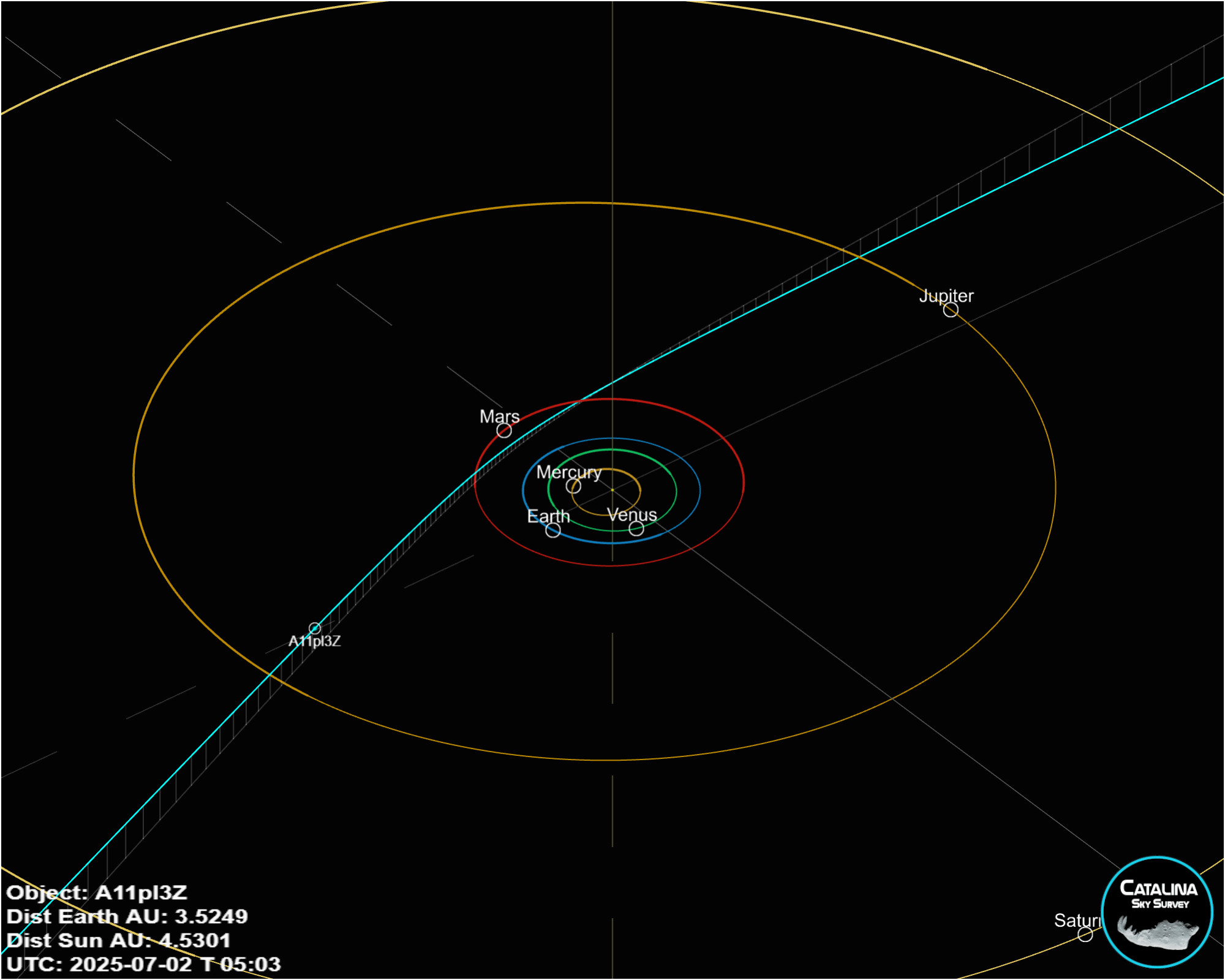https://www.virtualtelescope.eu/2025/07 ... july-2025/


BREAKING NEWS: 3I/ATLAS = C/2025 N1 (ATLAS), an interstellar object transiting the Solar System, has been discovered. SEE IT LIVE, online, from home!
On July 1st, astronomers discovered a celestial body passing through the region of the Sun, but originating from beyond the Solar System. Initially designated A11pl3Z, it received its official name just a few hours ago: 3I/ATLAS = C/2025 N1 (ATLAS). This is only the third such object ever found, after 1I/ʻOumuamua in 2017 and 2I/Borisov in 2019.
It was first spotted by the Chilean station of the ATLAS project, dedicated to the search for near-Earth asteroids, but previous unnoticed images of the object were soon found. The Minor Planet Center promptly called for necessary follow-up observations and published preliminary data on its website, along with the temporary designation A11pl3Z, under which the object quickly gained attention.
From the beginning, its interstellar nature was evident due to its high velocity at infinity (hyperbolic excess velocity) of nearly 60 km/s, corresponding to a strongly hyperbolic orbit with an eccentricity of 6.2—by far the highest among the three interstellar objects known to date.
At the time of discovery, 3I/ATLAS was about 520 million km from Earth and 670 million km from the Sun, within Jupiter's orbit and rapidly approaching. Its brightness was around magnitude 18.5, making it about 2.5 million times fainter than Polaris. It is currently photographable with telescopes of approximately 150–200 mm in aperture.
Within 24 hours, the first signs of cometary activity were reported, leading to the additional designation C/2025 N1. Currently, its estimated diameter is around 20 km, though this comes with significant uncertainty due to limited data and the object’s true brightness, which may currently be boosted by a temporary outburst.
3I/ATLAS will reach perihelion (closest point to the Sun) on October 29, passing at just over 200 million km from our star at a speed of about 68 km/s. On October 2, it will be only 30 million km from Mars, and on December 19, it will make its closest approach to Earth, passing at around 270 million km from our planet.
From Earth, 3I/ATLAS is currently visible in the constellation Sagittarius, transiting in the southern sky in the middle of the night. As mentioned, it can be photographed using telescopes with at least 150–200 mm of aperture, but the full Moon on the 10th will soon make observations increasingly difficult. In the coming months, however, it will become easier to observe even with small instruments.
I personally observed 3I/ATLAS on the evening of July 2, before its official announcement. The observation was made using a 360 mm telescope located in Manciano (GR), Italy, under one of the darkest skies of the Italian mainland. The resulting image is attached.
I have also created the attached star map, showing the path of 3I/ATLAS among the stars until December 30, 2025.
This evening, July 3, starting at 22:00 UTC the Virtual Telescope Project will stream a live view of the interstellar object 3I/ATLAS on its website, the link available in the comments.
Clear skies,�Gianluca Masi
Virtual Telescope Project
https://www.seti.org/news/comet-3iatlas ... ar-system/"Observations en cours sur plusieurs fronts
Surveillance optique par le biais de la science citoyenne
Dr. Graykowski dirige les efforts de surveillance optique à l'aide du réseau UNISTELLAR, un réseau décentralisé de petits télescopes intelligents exploités par des scientifiques citoyens du monde entier. Malgré la faiblesse de l'objet, les télescopes UNISTELLAR (avec des ouvertures de seulement 3-4,5 pouces) l'ont détecté avec succès à l'aide de techniques d'empilement d'images pour compenser le mouvement rapide de la comète.
Les premières mesures de luminosité révèlent une forte augmentation de la luminosité, ce qui est cohérent avec les nouvelles comètes dynamiques qui se rapprochent pour la première fois d'une étoile. Cet éclaircissement rapide reflète la sublimation de composés volatils qui sont restés inchangés depuis leur formation, offrant une occasion unique de sonder les matériaux interstellaires primordiaux.
Observations radio à la barre des télescopes Allen
Les observations radio ont commencé rapidement à l'Allen Telescope Array (ATA) de l'Institut SETI, dirigé par le Dr. Wael Farah. L'équipe de l'ATA a entrepris une surveillance dans la nuit du 2 juillet, ciblant à la fois les émissions à bande étroite (un indicateur potentiel des signaux artificiels (technologiques)) et les émissions naturelles telles que le rayonnement continu de la poussière et les lignes spectrales spécifiques associées à des molécules communes comme l'hydroxyle (OH).
En l'espace d'une semaine seulement, l'ATA avait amassé plus de 21 téraoctets de données, soit l'équivalent de milliers d'heures de vidéo haute résolution. Cet ensemble de données fait l'objet d'une analyse active, les chercheurs retraçant les données à la fois pour les signatures radio naturelles et les technosignatures hypothétiques.
Perspectives d'analyse spectroscopique
Observations futures de grandes installations, y compris la Vera C. L'observatoire Rubin permettra des études spectroscopiques détaillées, qui sont une technique utilisée pour déchiffrer la composition chimique des objets astronomiques. La spectroscopie permettra aux scientifiques de déterminer si 3I/ATLAS abrite des composés exotiques que l'on ne trouve pas couramment dans les comètes du système solaire.